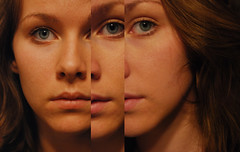 |
| Image via Green Heat |
The 10% Solution teaches writers how to cut their manuscripts by searching out words indicating weak sentence structure and rewriting for stronger, clearer sentences.
In my favorite segment, the author points out that writers force ourselves to be schizophrenic in order to serve the dual functions of writing and editing:
Writers divide their brains into the art department, which creates the stuff, and the marketing department, which peddles it. The art department is subdivided into creative (right brain) and editorial (left brain). Writers are schizophrenic.Later in the book, he calls this a "deliberate schizophrenic state", and that analogy pinpoints one reason the editing process is so difficult. Most aspiring writers understand that we have to "get distance" from a piece to edit it effectively, but I hadn't considered that I might also be getting distance from myself. When we write, we reach for emotions--maybe something we've experienced, or maybe with intuitive empathy--and finishing a scene, a chapter, a story, gives us both a sense of satisfaction and a sense of catharsis for those emotions we've dredged up.
Successful writers separate their brain functions deliberately and at will. They write with passion, from the head and the heart. They write fast. They dispassionately edit what they've written as if somebody else wrote it.
 If we can't get enough distance from the "self" that wrote it, editing might feel like denying that experience. That's why the "deliberate schizophrenic state" makes so much sense to me. In order to edit objectively, we have to cut ourselves off from the self that has emotional connection to that piece. That can be really difficult, and it requires practice, and time. Just like time is the greatest healer, it's also the best thing to create distance for a piece.
If we can't get enough distance from the "self" that wrote it, editing might feel like denying that experience. That's why the "deliberate schizophrenic state" makes so much sense to me. In order to edit objectively, we have to cut ourselves off from the self that has emotional connection to that piece. That can be really difficult, and it requires practice, and time. Just like time is the greatest healer, it's also the best thing to create distance for a piece.But what if you don't have time?
If you're like me, when you finish a piece, you Must Do Something Right Now to start polishing it. One thing I like about The 10% Solution is that I can edit a piece right away. It gives me the ability to look at sentences out of context, which severs the connection to story. (I've also heard of people reading backwards, sentence by sentence, to the same effect. I've never been able to do that.)
By searching for "ly", we can judge whether that particular adverb is necessary within that sentence, and then jump to the next without ever having to read more than a sentence. It's a great exercise in objectivity to edit this way, because we don't get caught up in the emotion, in the current of the story. It's just words. I was able to cut about 1,000 words of an 8,600 word short story using this method.
The method's strength is limited to the technical level, but I think the idea of a deliberate schizophrenic state goes beyond simply editing your words. Where being "schizophrenic" helps the most is in getting feedback from other people. It's easy to slip into "writer" mode and cling to the piece when getting a critique, but the distance of the "editor" mode will dampen the emotional connection, sort of like laughing with people rather than being laughed at.
While I certainly do not suggest cultivating schizophrenia, I think we as writers do need to learn to wear many different hats. I recommend the ones below for both fashion and usefulness.
 |
| The Writer Hat |
 |
| The Editor Hat |
 |
| The Marketer Hat |
 |
| The "I'M PUBLISHED" Party Hat (by Santiago) |